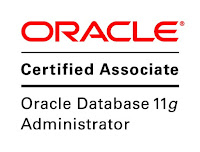Drop Table relies on recyclebin.
SQL> select * from tab;
TNAME TABTYPE CLUSTERID
------------------------------------------------------------------
CITY TABLE
INFO TABLE
SQL> drop table city;
Table dropped.
SQL> select OBJECT_NAME,ORIGINAL_NAME,OPERATION from USER_RECYCLEBIN;
OBJECT_NAME ORIGINAL_NAME OPERATION
---------------------------------------------------------------------------------------------------------
BIN$SvRkQnfIYM3gUwEAAH9==$0 CITY DROP
SQL> select * from tab;
TNAME TABTYPE CLUSTERID
---------------------------------------------------------------------------------------------
BIN$SvRkQnfIYM3gUwEAAH9==$0
INFO
SQL> flashback table city to before drop;
Flashback Complete.
SQL>select OBJECT_NAME,ORIGINAL_NAME,OPERATION from USER_RECYCLEBIN;
no rows selected
SQL>select * from tab;
TNAME TABTYPE CLUSTERID
------------------------------------------------------------------
CITY TABLE
INFO TABLE
# If we drop the table with the purge option then it cannot be retrive
SQL>drop table city purge;
Table dropped.
SQL>select OBJECT_NAME,ORIGINAL_NAME,OPERATION from USER_RECYCLEBIN;
no rows selected
SQL>select * from tab;
TNAME TABTYPE CLUSTERID
-------------------------------------------------------------
INFO TABLE
SQL> select * from tab;
TNAME TABTYPE CLUSTERID
------------------------------------------------------------------
CITY TABLE
INFO TABLE
SQL> drop table city;
Table dropped.
SQL> select OBJECT_NAME,ORIGINAL_NAME,OPERATION from USER_RECYCLEBIN;
OBJECT_NAME ORIGINAL_NAME OPERATION
---------------------------------------------------------------------------------------------------------
BIN$SvRkQnfIYM3gUwEAAH9==$0 CITY DROP
SQL> select * from tab;
TNAME TABTYPE CLUSTERID
---------------------------------------------------------------------------------------------
BIN$SvRkQnfIYM3gUwEAAH9==$0
INFO
SQL> flashback table city to before drop;
Flashback Complete.
SQL>select OBJECT_NAME,ORIGINAL_NAME,OPERATION from USER_RECYCLEBIN;
no rows selected
SQL>select * from tab;
TNAME TABTYPE CLUSTERID
------------------------------------------------------------------
CITY TABLE
INFO TABLE
# If we drop the table with the purge option then it cannot be retrive
SQL>drop table city purge;
Table dropped.
SQL>select OBJECT_NAME,ORIGINAL_NAME,OPERATION from USER_RECYCLEBIN;
no rows selected
SQL>select * from tab;
TNAME TABTYPE CLUSTERID
-------------------------------------------------------------
INFO TABLE








































